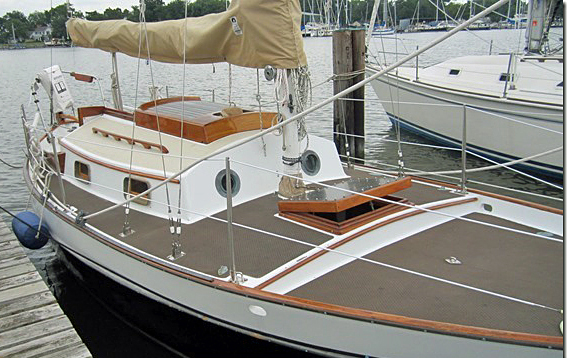A SAFE AND MANUALLY MANAGED OCEAN VOYAGING YACHT
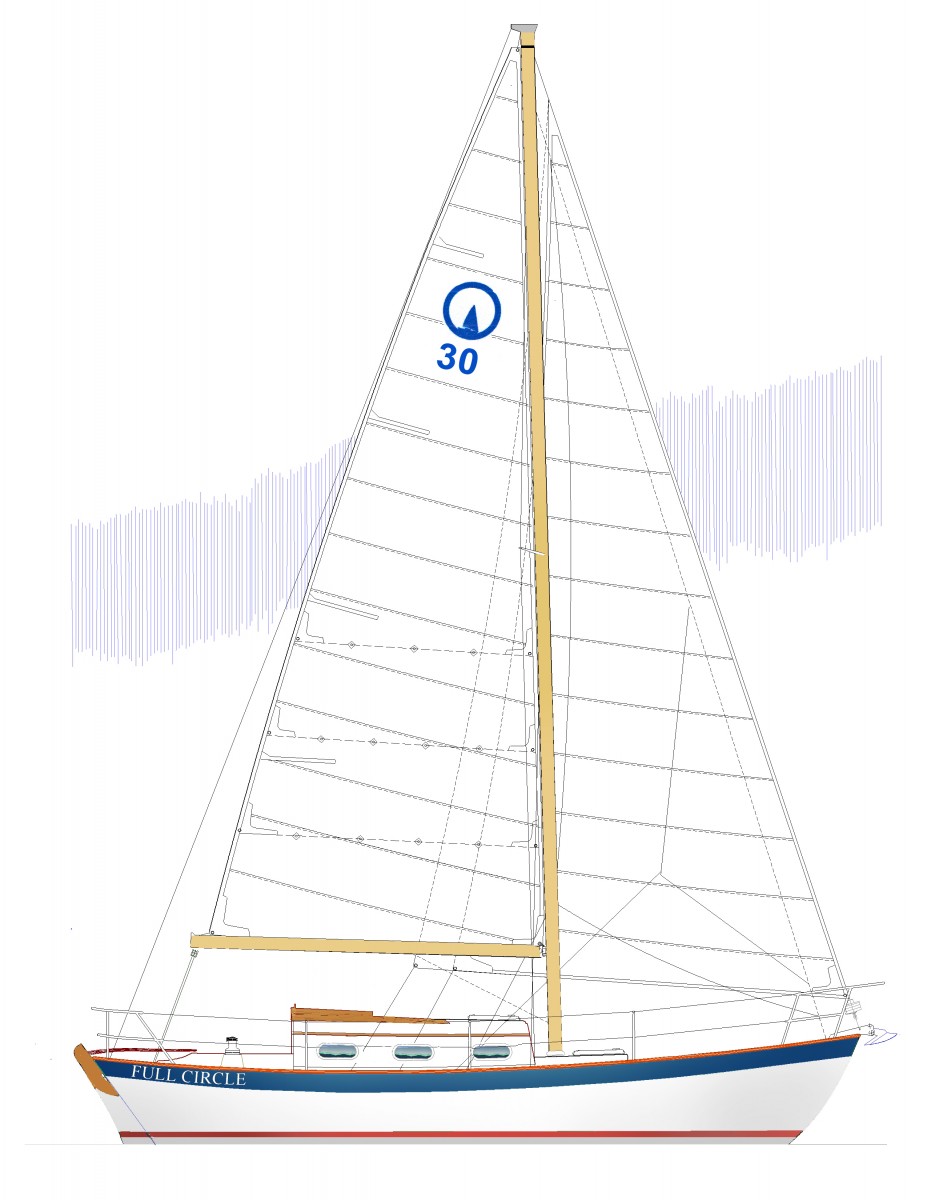
ABOUT TWO YEARS ago I began designing my swan-song yacht- the one my many yachting friends all predicted I would have no choice but to design. I started at an overall length of 28 feet but found it too small to really work so laid it aside in favor of this 30-footer that will work very well indeed. This is my “end of the world” design… the sanctuary you will bolt to if your nearby city has been vaporized by a nuclear warhead or simply if the kids are grown up, you’ve come into a pile of money, and you want to see the watery part of the world. It will be fun to sail, beautiful, and capable of safely sailing to the tropical paradise of your choice. If fitted with new sails, and a recently cleaned bottom, it will even sail well enough to win races in the increasingly popular Classic Yacht classes. It will be built in WEST System cold molded construction, epoxy glassed over for durability.
The FULL CIRCLE 30 is intended to be the ultimate small oceangoing yacht, from a guy who knows that the adjectives small and oceangoing are usually mutually exclusive. Having designed four highly regarded double-enders early in my career from which over 300 individual yachts were built, I have perceived the need for my last and best such yacht. She is designed to the KISS principle – Keep It Simple Stupid. Everything is manually operated- the steering, hoisting and trimming of sails, anchor handling, docking, etc. The motor is used only for propulsion. Any convenience gadgets are small and easily replaceable.
Presented here is the smallest, cheapest to maintain, singlehanded or doublehanded-capable yacht that can safely ply the open oceans of the globe. She will be of WEST epoxy cold-molded construction using computer generated lines fairing to make her construction as economical as possible. Her construction material cost will range from $200,000 to $300,000 depending upon whether the mast is of aluminum or carbon fiber, and whether an internal combustion or electric motor is used for her propulsion. The labor to build her will range between 2500 and 3500 manhours in a shop with proper tools. So the regrettable fact is that you will have to be at least a millionaire to have one.
Her predecessors:
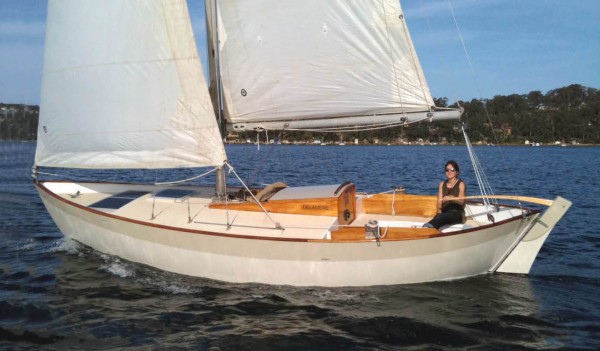
THE 24′ CAROL. All were custom built from our plans. We sold something like 30 sets of plans. I’d estimate a third of that number actually got launched. Among our four double-enders, the CAROL was the best performer for its length, probably because it had the lightest Displacement/Length ratio of the four designs.
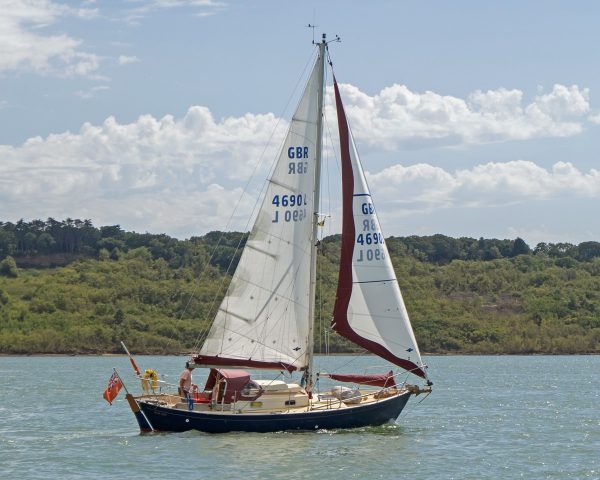
The 26′ FRANCES, built by Tom Morris in the USA and Victoria Yachts in Britain. This is a British built cutter rigged FRANCES. It had the heaviest D/L ratio of my four designs at 335, so was the most modest performer. But she surprised people with how well she could go despite her weight and more than 200 yachts were built to the design. Quite a few have completed major ocean crossings and three have ranged to and across the Pacific Ocean.
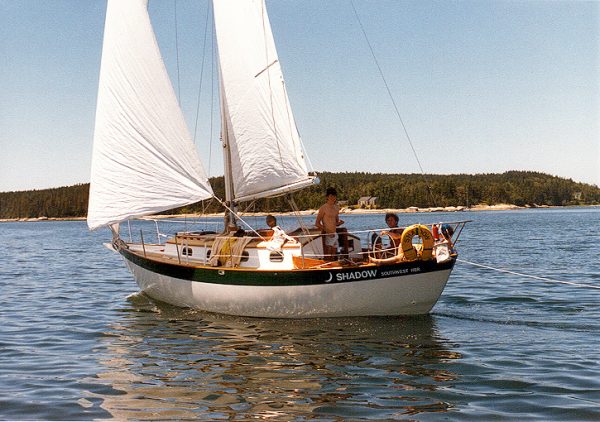
THE LEIGH 30, with Tom Morris at the helm. Also built in the UK as the VICTORIA 30. Approximately 100 of the yachts were built.
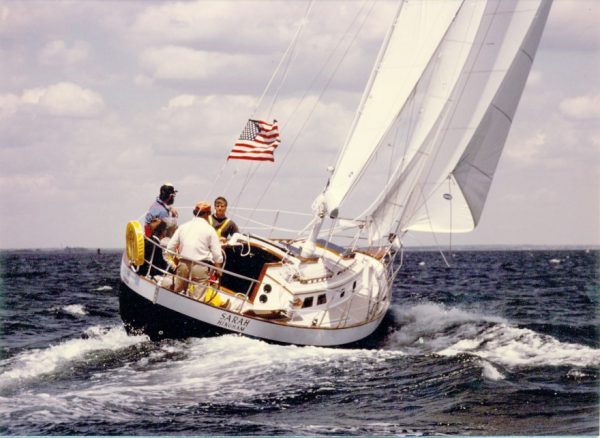
The SARAH 32. They were built by Loomis yachts first in Massachusetts then in Florida. About 10 yachts were built. One has circumnavigated while others have crossed the Atlantic.
The FULL CIRCLE 30 incorporates all I have learned from the previous four double-enders. Included in its design are a lifetime’s ideas that will make her the perfect single person or small family cruiser:
-
Hull lines of moderate, towards heavy, displacement with a relatively short full keel to reduce the wetted surface. The popularity of the heavy double-ended hull began with Colin Archer’s Redningsskøyte, sailing lifeboats that would put to sea in truly dangerous weather to save one’s fellow mariner. This double-ended hull is the ultimate hull shape for efficient, reassuring, stable, easily steered cruising in the open ocean- I challenge you to find anything remotely comparable unless the ocean changes shape. The FULL CIRCLE 30 has the lightest Displacement/Length ratio of all my double-enders, at 279. So she should be the fastest for her length.
-
Small enough to keep marina fees, haulout fees, customs duties, and replacement costs (sails, cordage, bottom paint, etc) at the absolute minimum. Also so as not to be an affront to the subsistence-economy residents of the far-flung islands you will visit. And to have modest forces on her sheets and main halyard so as to not intimidate a female shipmate, and to enable you to sail her until well into your dotage without crew. This is a yacht that a singlehander, or a strong and agile guy with a less physically gifted wife (or the other way around), can take to sea.
-
Large enough to have a comfortable motion at sea and to sail at over 6.5 knots in a decent breeze, and to “feel” like a much larger vessel. It will accommodate a family of two parents and two children, or four adults if they do not require privacy. For ocean crossings two couples – one on watch and the other sleeping – would be ideal, while once you get to paradise one couple would find her very comfortable.
-
Lots of stability owing to a deep enough keel and plenty of outside lead ballast combined with a whole lot of batteries and tankage located low in the hull. Enabling a sailplan large enough to really get this yacht going, to the extent that she could even be raced in the proper venues. Some classic yacht rating rules will give a 10% handicap credit for the double-ended shape, which could, if you are a great helmsman, make her unbeatable.
-
The keel is shortened fore and aft by being well cutaway forward and having its aft end faired into a large “aperture” so that a balanced, spade-like rudder may be fitted. The shortened keel and perfected hydrofoil shape will enable her to point higher than any extant double-ender. The rudder is also well protected by the keel in the event of a grounding.
-
A continuous underbody profile from stem to stern. Meaning no worrying about sailing at night when you cannot avoid lobsterpot lines or ropes of kelp or other flotsam… these will be conveniently shed and left astern. When racing, snagging just one such object will quickly put you at the back of the fleet. Not aboard this boat.
-
An open interior, not chopped up by bulkheads, so there is excellent ventilation and lighting of the accommodation space from one end to the other and none of the claustrophobic feeling of many other yachts.
-
A Dutch door into the head. The idea here is that the top third of the door will be kept open whenever the head is not occupied. Thus you can see all the way across the boat including out the port side windows, and the ventilation from the opening port in the head will contribute to that of the whole boat. The bottom part would be kept closed except when access is needed. Thus it will serve as a barrier to prevent anyone– particularly the cook when at work– being propelled into the head by an errant wave.
-
A rainwater collecting system. It will supply fresh water tanks usable for bathing and washing dishes. A separate potable water tank will be fitted. After enough rain has fallen to remove salt encrustation from the foredeck, Y-valves can be rotated port and starboard that divert the rain away from the scuppers and into the tanks. The entire recessed forward deck you see in this photo of a FRANCES is the rainwater collection basin.
-
Excellent ventilation: There are a total of eleven opening portholes. One at the forward end of the raised deck on centerline, two facing forward and two facing aft in the house front and rear, and three on either side of the house. A large hatch in the raised deck forward of the mast and another on the forward lowered deck which can be left open even in quite heavy weather when the dinghy is stored upside down on deck so it will shed spray. And one opening hatch in the housetop which can be opened in fine weather. For ventilation when nobody is aboard there are at least one pair of Dorade vents.
-
A well lit interior. There are six houseside windows, in additional to all of the ports and hatches mentioned above. Also at least two deck prisms are recommended.
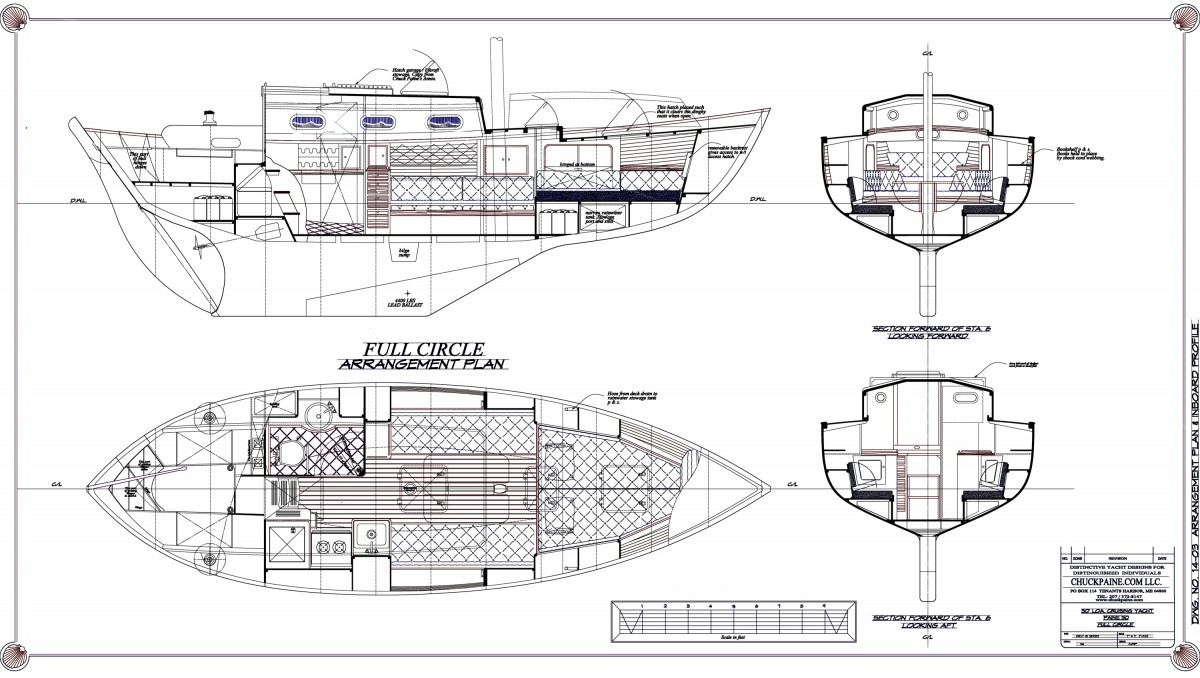
-
Adequate headroom in the areas where one needs to stand- the main cabin, galley and head- if you are less than 5′-11″ in height. (Six-foot headroom on the centerline). If you are taller, contact me and I will direct you to an appropriate alternative design- whether one of my own or from one of my esteemed colleagues. Or I could redesign the house a bit taller. This brings up the question… why the short house? After all wouldn’t it be nicer to have headroom forward of the mast? The answer is… the dinghy. You cannot live aboard a yacht without a really good dinghy. You cannot just sail into every port or Pacific atoll and rent one- you have to carry it with you. You can’t store it on davits on the stern for numerous reasons… the windvane steerer conflicts with this idea, the boat is too small to sling a proper sized dinghy sideways across the stern, etc. It doesn’t fit on the housetop. So it’s got to go forward of the mast. And this deck configuration shown above is ideal for storing a good sized dinghy upside down just in front of the mast without impeding visibility or access to the bow. When in place it forms a convenient shelter to keep spray from getting beneath it. So you can keep the two opening hatches and one opening port beneath it open a crack.
-
Immediate access, including visual access, to all of the things that can go wrong or get you worrying whether something might have gone wrong. Including: A glass inspection window in the cabin sole above the bilge sump, and a switchable guarded light in the bilge, so you can immediately see every time you come aboard, or at every change of watch at sea, if there is water in the bilge. A hinged access hatch through the forward bulkhead that when opened shows you if the anchor rode is snarled or not, and enables you to fix it if it is. It is hidden from view by a removable cushion.
-
Two sea-chests, one inlet and one outlet, – so that all of the seacocks are clustered together in the same location– a space aft of the toilet that I call the Medusarium. If you ever discover a frightening amount of water in the boat, they can all be closed quickly and the boat pumped dry, then opened one by one until the offending member is discovered. The toilet holding tank exit throughull will be separate, but in the same location. The most frightening and potentially catastrophic scenario in yachting is a hose popping off a throughull and the height of water such that the source of the ingress is underwater, making it impossible to know which throughull is responsible.
-
All of the toilet hoses out in the open, in the Medusarium… not pretty but if something begins to smell or leak, you can find and fix it easily.
-
The simplest holding tank solution that complies with all regulations and enables any harbormaster to verify that you are a responsible steward of the environment. It can be dumped at sea by gravity- no machinery is involved- or in the usual way via a deck fitting when in harbor.
-
Loose, replaceable pieces of convenience gear– not a lot built-in. Including: Entertainment system… a boom-box- easily replaced anywhere in the world when it craps out. A 12 volt WEST or YETI freezer chest in a dedicated, easily accessed space aft of the companionway ladder- no built-in refrigeration. A diesel powered electric generator that lives in the cockpit locker. If it fails, go to the local equivalent of West Marine and buy another. And most important, no built-in electronic navigation. Any Ipad or Iphone can do this task now, and if it fails no matter– it is easily replaced. No SSB radio– the Iphone or Ipad can take its place with the right app. Of course should you wish, a more extensive chartplotter can be fitted.
-
Either no, or very little, varnished irreplaceable tropical hardwood. Virtually everything is painted, and thus easily maintained anywhere in the world. If the designer is skilled enough, his sensuous shaping of the vessel will not require gilding his lily with varnish. What looks like maybe varnished wood at the sheerline in the accompanying drawings is paint of a wood color. On my yacht I would use Awlgrip everywhere, not common enamel.
-
A balanced rudder– with part of its area forward of the pivot axis– just like the racing yachts. Keeping helm forces at a minimum and enabling a self-steerer or autopilot to actually work well, even downwind.
-
Room enough for an 8 1/2-foot dinghy to be carried upside down forward of the mast while on passage. Or one of the numerous available nesting two-part dinghies, which make getting ashore or more importantly back home when possibly more than a few sheets to the wind, sure and safe. This item might be modified as more and more dinghies are invented. The ideal solution would be a very large, probably roto-molded dinghy like an overgrown sit-on rather than sit-in kayak, that could be towed behind even in storm conditions but sufficiently self-bailing to be unsinkable. I’m still on the hunt for this item.
- A big rig with plenty of sail area. The hull has a lot of stability so why not pile on the sail to make her go fast? She has an “almost masthead” rig but there is about a foot of fraction at the top of the mast so that spinnakers or light air reachers can be set without chafing on the upper swivel of the roller furler.
- No mainsheet traveler. I consider this to be a dangerous device which not should be placed anywhere near unsuspecting kiddies’ hands or bodies. Instead a solid “quick” vang is used to control mainsail twist, and the tried and true four-part mainsheet with a camcleat on the starboard side block is specified.
-
A deployable Solent Stay, enabling the Genoa to be rolled up in heavy weather and a smaller working jib or storm jib to be deployed when necessary. It would be taken back to the mast when not in use so as to permit the jib to be tacked.
-
An unusual amount of usable interior space. Years ago at the behest of Tom Morris and Peter Gregory (Victoria Yachts in the UK) I designed for my Frances 26 design a raised deck amidships with a short cabin situated atop it. The feeling of space this engenders has to be seen to be appreciated- this 30-footer will “feel” like a much larger boat than its length might imply.
-
Mechanical propulsion most likely by electric motor. The day of the internal combustion engine may be behind us. Charging will be by windmill and solar panels, as well as shore power when at a dock or marina. And you can now buy “contractor’s generators” that can feed battery chargers and when they give up the ghost, buy another at a modest price. Of course if your intended use of the yacht is not in the tropics where there is abundant sunshine, you may choose to fit a diesel motor. Note that the elimination of an internal combustion engine would also eliminate two thruhulls– for the non-existent cooling water inlet and the engine exhaust – and increase storage room in the galley.
-
The cabin top is not curved but of a faceted shape so as to better accommodate solar panels. The common cockpit spray dodger and Bimini are replaced by a unique solution that permits solar panels to be fitted atop what would otherwise be a Bimini.
-
Access to the water will be made easier for dinghy boarding, swimming, or man-overboard rescue, by a section of the port side topsides aft being hinged to flop down so that a stainless steel ladder can be easily put in place for re-boarding.
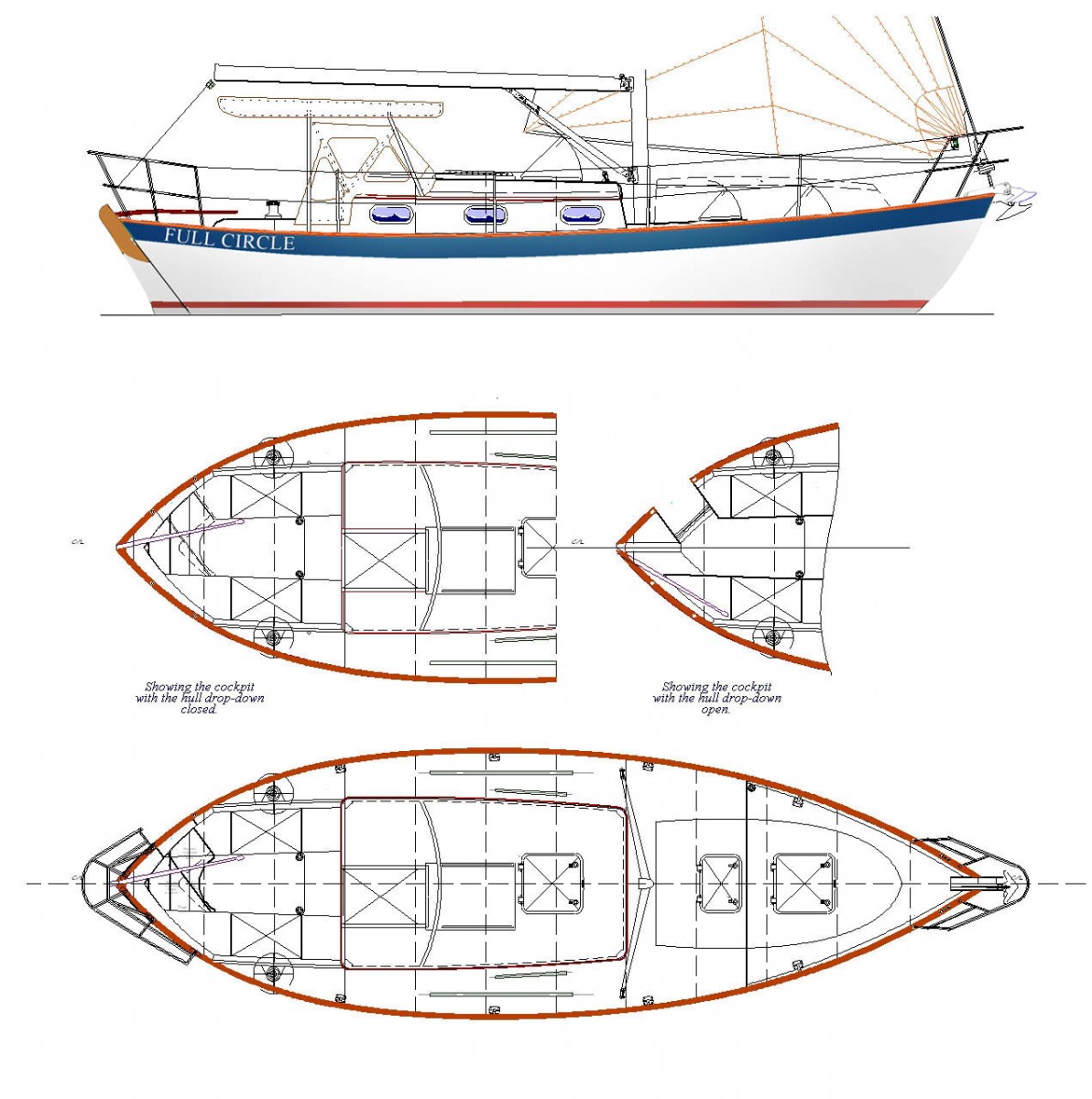
Luxurious…NOT. The idea is to leave your former life ashore and learn to use your God-given body to be physical and self-reliant again. The only luxuries recommended have to do with primal needs. The shower in the head to stay clean. An outdoor fresh water shower near the aft boarding access allows a brief rinse-down after swimming that can make you feel like a new person. A heater of some sort to keep the interior temperature comfortable at three in the morning. A boom box for Mozart. All the books you never read in your life. And that’s about it for luxuries.
I suppose my life has gone full circle. At the age of 14 my twin brother and I built my first sailboat- a Bluejay named Scratch. The next year a sailing friend commissioned another. Over the years I’ve built two other wood boats, though these were of much trickier and more costly cold molded epoxy construction. And I’ve built three other sailboats between 26 and 30 feet in length, of fiberglass. In my youth I was ambitious to make my fortune. I ran my yacht design company during the conventional 40-hour work weeks and it turned into a real success, but then there were the evenings and weekends when others took their leisure. I used this extra time to build yachts on spec and sell them at a profit. Now in my dotage I’ve got the itch to build just one more. If I actually do my life will have gone full circle, so I think that’s what I’ll name her.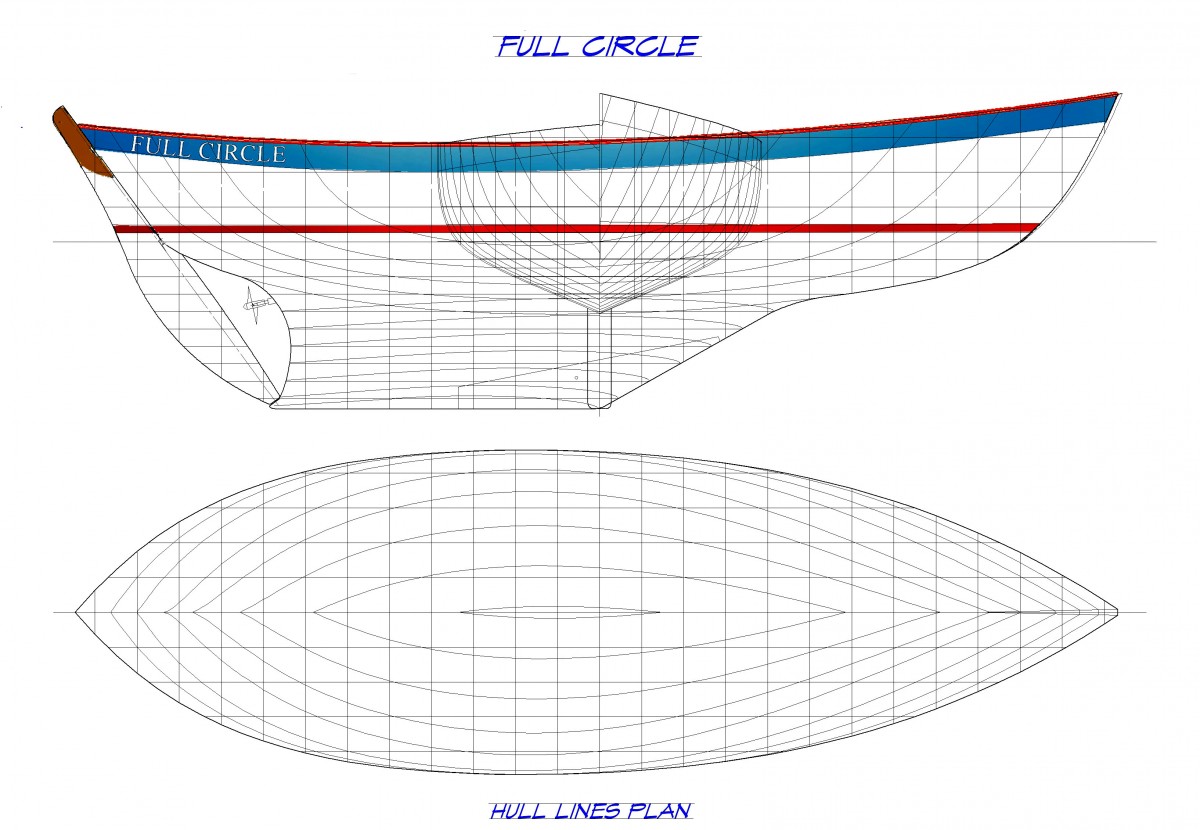
Stay tuned to this website where I’ll post more drawings as I get them done. And by all means if you want to have one of your own and maybe sail her around the world, please contact me. Your voyage will lend added meaning to the name.
I am designing this yacht slowly and carefully and am describing the process in real time in posts to the Chuck Paine Yacht Designs Facebook Group. The idea is for me to keep my hand in as a designer in my dotage, to educate the more than 7900 members of the Facebook Group and solicit their input to better perfect the design, and to seek out one well-heeled patron to see the design to its completion. The hours that are expended to complete the design are being tallied, and a yachtsman who wishes to build the design will be asked to reimburse the cost of the complete design at approximately half the hourly rate that he pays to service his automobile.
Please feel free to contact me at paineyot@aol.com if you have any questions.

